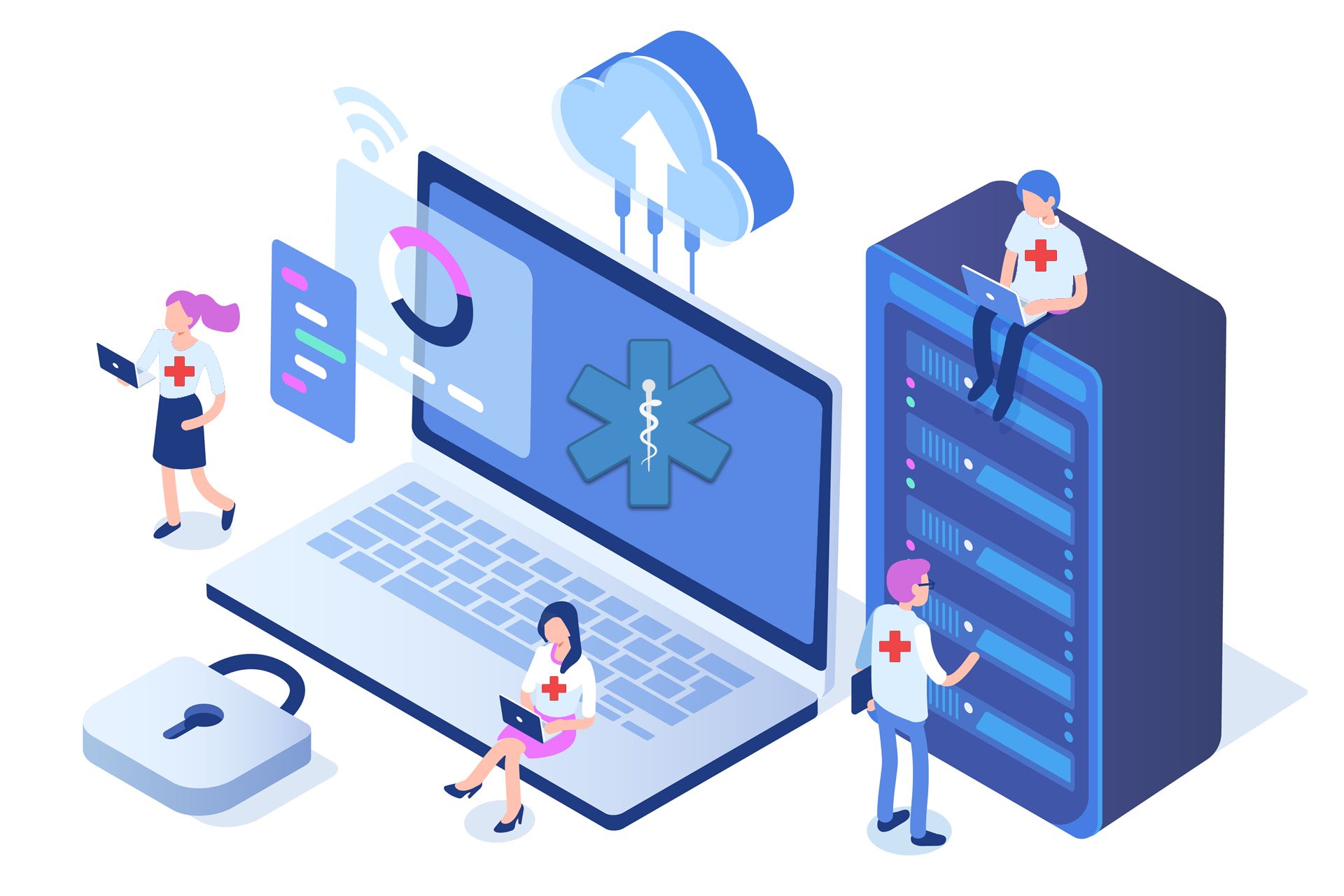In the age of big data, privacy regulations have become increasingly rigorous, especially for international organizations. Two of the most influential regulations in this space are the California Consumer Privacy Act (CCPA) and the General Data Protection Regulation (GDPR). Both laws protect individual privacy rights but differ in scope, requirements, and enforcement mechanisms. For any organization operating within California or the European Union, a deep understanding of CCPA and GDPR is essential to maintain compliance and protect its users' privacy.
This article breaks down the critical elements of CCPA and GDPR, highlighting their similarities and differences to help you understand each regulation's scope, requirements, and penalties. Whether you're a business owner seeking compliance or an advocate for data privacy, this guide will help you navigate the current privacy regulation environment.
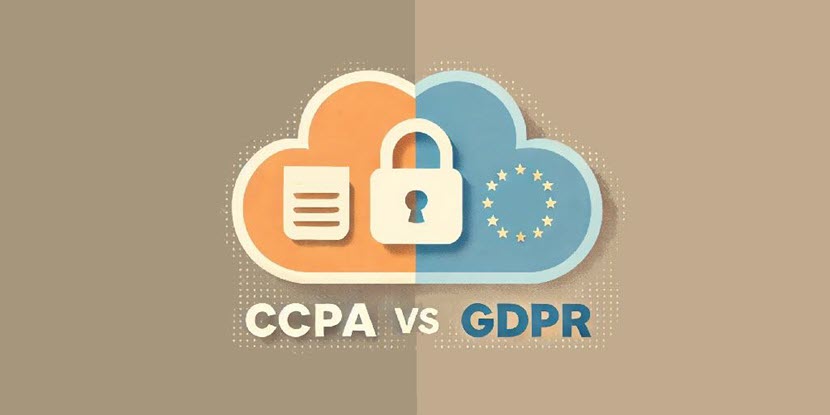
What Does CCPA Stand For?
The California Consumer Privacy Act (CCPA) is a U.S. state law enacted to enhance California residents' privacy rights and consumer protection. Effective January 1, 2020, the CCPA grants individuals greater control over how businesses collect, use, and share their personal information. It imposes specific obligations on businesses to promote transparency and accountability in handling consumer data.
Key elements of the CCPA include:
- Scope of applicability. The law applies to for-profit entities that do business in California and meet certain thresholds related to annual revenue, the amount of personal information handled, or the percentage of revenue derived from selling personal data.
- Enhanced consumer control. California residents have the right to access the personal information collected about them, request deletion of their data, and opt out of the sale of their information to third parties.
- Business compliance requirements. Companies must provide clear notices about their data collection practices and establish procedures to respond to consumer requests regarding their personal information.
- Non-discrimination clause. Businesses are prohibited from discriminating against consumers who exercise their rights under the CCPA, ensuring equal service and pricing.
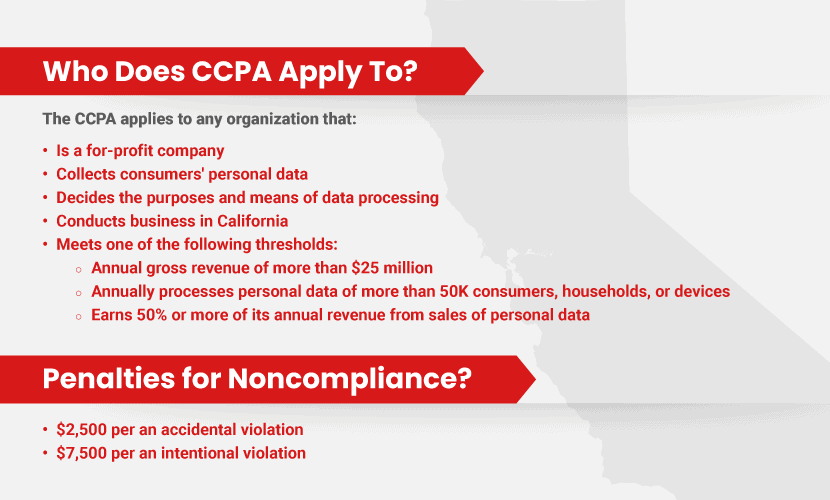
What Does GDPR Stand For?
The General Data Protection Regulation (GDPR) is a comprehensive data protection law enacted by the European Union (EU) to enhance the privacy and protection of personal data for individuals within the EU and the European Economic Area (EEA). Effective May 25, 2018, the GDPR replaces the 1995 Data Protection Directive and serves as a uniform standard for data privacy across all EU member states. It imposes strict rules on how organizations collect, use, and store personal data, emphasizing transparency, security, and accountability.
Key elements of the GDPR include:
- Scope of applicability. The regulation applies to all organizations, regardless of their location, that process the personal data of individuals residing in the EU. This includes companies outside the EU that offer goods or services to EU residents or monitor their behavior.
- Enhanced individual rights. EU residents are granted extensive rights over their data. These rights include access to their data, rectification of inaccuracies, erasure (the "right to be forgotten"), restriction of processing, data portability, and the right to object to certain processing activities.
- Business compliance requirements. Organizations must adhere to stringent guidelines for obtaining valid consent, provide clear and accessible privacy notices, implement data protection by design and default, and establish procedures to handle data subject requests efficiently.
- Data Protection Officer (DPO). Under certain conditions, organizations must appoint a Data Protection Officer responsible for overseeing GDPR compliance, advising on data protection obligations, and serving as a contact point for supervisory authorities and data subjects.
The GDPR is a significant shift in data privacy regulation on a global scale. It has set a new international benchmark for privacy laws, prompting many countries to update or enact their own data protection regulations.
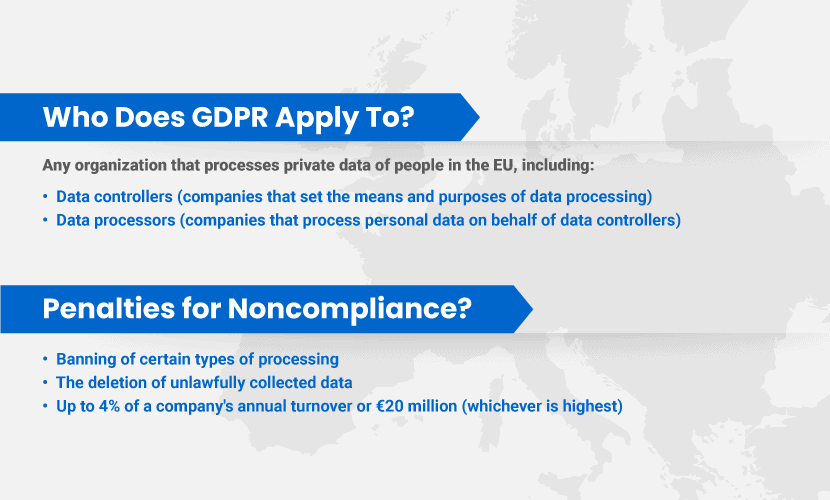
CCPA vs. GDPR: Key Differences
The following table provides a brief overview of the differences between CCPA and GDPR:
| Aspect | CCPA | GDPR |
| Applicability | For-profit businesses meeting certain thresholds in California. | All organizations processing personal data of EU residents. |
| Protected data | Personal information relating to California consumers or households. | Personal data relating to identified or identifiable individuals in the EU. |
| Consumer rights | Right to know, delete, opt out of sale, and non-discrimination. | Rights to access, rectify, erase, restrict processing, data portability, object, and rights related to automated decision-making. |
| Legal basis for processing | Not specified; focuses on data sales and disclosure. | Requires a lawful basis for processing, such as consent or legitimate interests. |
| Consent requirements | Opt-out model for data sales; opt-in consent required for minors under 16. | Consent must be freely given, specific, informed, and unambiguous; opt-in model. |
| Enforcement and penalties | Civil penalties up to $7,500 per intentional violation; private right of action for data breaches. | Fines up to €20 million or 4% of global turnover; enforced by Data Protection Authorities. |
| Data breach notification | No specific timeframe; governed by general California laws requiring notification without unreasonable delay. | Mandatory notification to authorities within 72 hours; immediate notification to individuals if high risk is determined. |
| Data transfer restrictions | No specific restrictions; businesses must ensure third parties uphold CCPA protections. | Strict restrictions; transfers outside the EEA require adequacy decisions or appropriate safeguards. |
| Data protection officers | Not required to appoint a DPO. | Mandatory appointment under certain conditions. |
| Privacy by design and default | Not explicitly required. | Mandated, organizations must implement data protection measures from the outset. |
| Children's data | Parental consent required for selling data of minors under 13; opt-in consent required for minors aged 13–16. | Parental consent is required for processing data of children under 16 (member states may lower to 13). |
| Automated decision-making | No specific provisions. | Grants rights related to automated processing, including profiling. |
| Record-keeping requirements | Not explicitly mandated. | Requires detailed records of processing activities. |

CCPA vs. GDPR Applicability
Understanding the applicability of each regulation helps businesses determine their compliance obligations.
CCPA
The CCPA applies to for-profit businesses that collect personal information from California residents and meet at least one of the following thresholds:
- Gross annual revenues over $25 million. Businesses exceeding this revenue are subject to the CCPA.
- Buy, receive, or sell personal information of 50,000 or more consumers, households, or devices. This includes businesses engaged in substantial data processing activities.
- Derive 50% or more of annual revenues from selling consumers' personal information. Companies that are heavily reliant on data sales fall under the CCPA.
GDPR
The GDPR applies to any organization processing the personal data of individuals residing in the EU, regardless of the company's location. Specifically, it applies to:
- Organizations established in the EU. All entities operating within EU member states must comply with the GDPR.
- Organizations outside the EU offering goods or services to EU residents. Companies targeting EU consumers are subject to the GDPR.
- Organizations monitoring the behavior of individuals in the EU. This includes businesses tracking the online activities of EU residents for profiling or analysis.
CCPA vs. GDPR Protected Data
The scope of protected personal data varies between the two regulations.
CCPA
The CCPA defines personal information broadly, focusing on information that identifies, relates to, or could be linked with a particular consumer or household. Examples include identifiers like names and addresses, commercial information such as purchase histories, internet activity like browsing history, geolocation data, and professional information. However, it excludes publicly available information and certain medical and financial data regulated under HIPAA and PCI DSS.
GDPR
The GDPR defines personal data as any information relating to an identified or identifiable natural person. This includes identifiers, special categories of data (like racial or ethnic origin, health data), economic data, and social identity data. Unlike the CCPA, the GDPR does not exclude publicly available information.
Consumer Rights
Both regulations grant specific rights to individuals, but the rights differ in scope.
CCPA
Under the CCPA, California consumers have several rights regarding their personal information:
- Right to know. Consumers can request information about the categories and specific pieces of personal data a business has collected about them.
- Right to delete. Consumers can request the deletion of their personal information, with certain exceptions.
- Right to opt out. Consumers can opt out of the sale of their personal information to third parties.
- Right to non-discrimination. Businesses cannot discriminate against consumers who exercise their CCPA rights.
The CCPA does not explicitly provide a right to data portability or correction of inaccurate data.
GDPR
The GDPR grants EU residents comprehensive rights concerning their data:
- Right of access. Individuals can access their personal data and obtain information about how it is processed.
- Right to rectification. Individuals can have inaccurate personal data corrected.
- Right to erasure (“right to be forgotten”). Individuals can request the deletion of their personal data under certain conditions.
- Right to restrict processing. Individuals can request limitations on how their data is processed.
- Right to data portability. Individuals can receive their personal data in a structured, commonly used format and transmit it to another controller.
- Right to object. Individuals can object to processing their personal data, including for direct marketing purposes.
- Rights related to automated decision-making and profiling. Individuals have rights concerning automated individual decision-making.
Legal Basis for Processing Data
The requirements for the legal basis of data processing differ between the two regulations.
CCPA
The CCPA does not require businesses to establish a legal basis for processing personal information. It focuses on data sale and disclosure practices, emphasizing the right of consumers to opt out of the sale of their personal information.
GDPR
The GDPR requires organizations to have a valid legal basis for processing personal data. Lawful bases include consent, contractual necessity, legal obligation, vital interests, public interest, and legitimate interests balanced against the rights of the data subject.
Consent Requirements
Consent plays a different role in each regulation.
CCPA
Under the CCPA:
- Opt-out model. Businesses can collect and sell personal information unless the consumer opts out.
- Minors under 16. Opt-in consent is required for the sale of personal information of consumers aged 13–16.
- Children under 13. Parental consent is required for selling personal information of children under 13.
GDPR
Under the GDPR:
- Opt-in model. Consent must be obtained before processing personal data when no other legal basis applies.
- Requirements for consent. Consent must be freely given, specific, informed, and unambiguous.
- Withdrawal of consent. Individuals can withdraw consent at any time, and it must be as easy to withdraw as to give consent.
Enforcement and Penalties
The enforcement mechanisms and penalties for non-compliance differ significantly.
CCPA
Enforcement is primarily the responsibility of the California Attorney General. Penalties include civil fines of up to $2,500 per violation or $7,500 per intentional violation. Consumers have a private right of action for data breaches resulting from inadequate security measures, with statutory damages ranging from $100 to $750 per consumer per incident. There is a 30-day cure period after receiving notice of non-compliance.
GDPR
The GDPR is enforced by Data Protection Authorities (DPAs) in each EU member state. Penalties are severe, with fines up to €20 million or 4% of global annual turnover, whichever is higher. There is no cure period, and penalties can be imposed without prior notice or opportunity to rectify. Individuals also have the right to seek compensation for damages resulting from GDPR violations.
Data Breach Notification
CCPA and GDPR have different requirements for notifying authorities and individuals about data breaches.
CCPA
Businesses must follow general California laws regarding data breach notification:
- Notification timeframe. Must occur "in the most expedient time possible and without unreasonable delay."
- Content of notification. Must include information about the breach and contact details.
GDPR
Here are the criteria for GDPR data breach notifications:
- Notification to authorities. The relevant Data Protection Authority must be notified within 72 hours of becoming aware of the breach.
- Notification to individuals. Required without undue delay if the breach is likely to result in high risk to individuals' rights and freedoms.
- Content of notification. Must include the nature of the breach, affected data subjects, consequences, and measures taken.
Data Transfer Restrictions
CCPA and GDPR have different approaches to data transfers outside their jurisdictions.
CCPA
Businesses must ensure third parties uphold CCPA protections when transferring personal information but face no specific restrictions on cross-border data transfers.
GDPR
Strict conditions apply under the GDPR:
- Adequacy decisions. Data transfers are permitted to countries that the European Commission has deemed to have adequate levels of data protection. This means the country’s data privacy laws provide protections comparable to those within the EU.
- Appropriate safeguards. For transfers to countries without an adequacy decision, organizations must implement specific safeguards. These include using Standard Contractual Clauses (SCCs)—pre-approved legal clauses that ensure EU-level protections—or Binding Corporate Rules (BCRs), which allow multinational companies to transfer data within their own corporate group while maintaining compliance.
- Derogations. In cases where neither adequacy decisions nor appropriate safeguards apply, GDPR permits certain exceptions, known as derogations, for specific circumstances. These include scenarios where the individual has given explicit consent for the transfer or where the transfer is necessary for contract fulfillment, legal claims, or other strictly defined purposes.
Data Protection Officers (DPOs)
The CCPA and GDPR take different approaches regarding appointing data protection officers.
CCPA
Under the CCPA, businesses are not required to appoint a data protection officer. However, they must ensure consumers have accessible methods to submit privacy requests, such as a toll-free number or online form, to help them exercise their rights effectively.
GDPR
The GDPR has specific requirements for appointing a data protection officer, especially for organizations involved in high-risk data processing. Here is a closer look at the conditions and responsibilities:
- Mandatory appointment under certain conditions. GDPR mandates that organizations appoint a DPO if they are a public authority, engage in large-scale monitoring of individuals (such as tracking online behavior), or process sensitive data on a substantial scale (such as health or racial data).
- DPO responsibilities. A DPO is responsible for overseeing data protection policies, conducting regular audits, training staff on best practices for data handling, and advising the organization on its GDPR obligations. Additionally, the DPO is the primary contact for both regulators and data subjects, responding to inquiries, managing data subject rights requests, and reporting data breaches to supervisory authorities as needed.
Privacy by Design and Default
CCPA and GDPR take different approaches to the integration of privacy measures.
CCPA
The CCPA does not explicitly require businesses to adopt privacy by design and default principles. However, it encourages companies to prioritize consumer privacy through other protective measures, such as enabling consumers to access, delete, and opt out of data collection.
GDPR
The GDPR requires organizations to implement “Privacy by Design and Default” principles at every stage of data processing. Here is what this means in practice:
- Privacy by design. GDPR requires organizations to integrate data protection measures into their processing activities from the outset. This principle applies to the entire lifecycle of data, from collection to deletion, and encourages organizations to incorporate privacy-enhancing technologies, conduct risk assessments, and design systems that minimize data exposure.
- Privacy by default. Under GDPR, organizations must ensure that, by default, they only collect and process the minimum amount of personal data required for a specific purpose. This principle limits data collection, restricting access to only those who need it, and setting conservative data retention policies.
Know the difference between security and compliance, two related concepts vital to cybersecurity.
Children's Data Protection
The CCPA and GDPR both offer protections for children's data, with GDPR implementing broader safeguards for young users’ privacy.
CCPA
Under the CCPA, businesses are required to obtain consent from minors or their parents when handling personal data in certain ways:
- Parental consent for children under 13. CCPA mandates parental consent before selling the personal information of children under 13.
- Opt-in consent for ages 13–16. For minors aged 13 to 16, the CCPA requires that they provide explicit opt-in consent before their personal information can be sold.
GDPR
GDPR takes a thorough approach to protecting children’s data, enforcing additional safeguards and standards to ensure their privacy:
- Parental consent for children under 16. GDPR sets the age of consent for processing personal data at 16, requiring parental consent for users under this age. However, EU member states can lower this threshold to as low as 13.
- Enhanced protections and clear language. GDPR requires that any privacy notices directed at children use clear and easily understandable language.
Automated Decision-Making and Profiling
CCPA and GDPR differ in their approach to regulating automated decision-making and profiling, with GDPR offering specific protections for individuals.
CCPA
The CCPA does not directly regulate decisions made solely by automated processes or offer specific protection related to profiling.
GDPR
The GDPR provides individuals with rights specifically related to automated processing and profiling, particularly when such processes impact their rights or freedoms:
- Right not to be subject to automated decisions. Under GDPR, individuals have the right to avoid being subject to decisions made solely through automated processing, especially when these decisions produce legal effects or significantly impact them (e.g., credit scoring or job selection).
- Exceptions to this right. There are certain cases where automated decision-making is allowed under GDPR, such as when individuals give explicit consent or when the decision is necessary for entering into or performing a contract. Even in these cases, organizations must implement safeguards to protect individuals’ rights.
Record-Keeping Requirements
CCPA and GDPR impose different obligations on businesses regarding record-keeping, with GDPR mandating more comprehensive documentation.
CCPA
The CCPA does not impose specific requirements on businesses to maintain detailed records of processing activities. While businesses are expected to manage personal data responsibly, the CCPA’s record-keeping requirements are minimal and focus primarily on giving consumers the right to access and delete their information.
GDPR
GDPR sets strict record-keeping obligations to ensure transparency and accountability in data processing. Organizations are required to keep detailed documentation of their processing activities, which must include:
- Purposes of processing. Clear descriptions of why personal data is being collected and processed.
- Categories of data subjects and personal data. Information on the types of individuals whose data is processed and the types of data collected.
- Data recipients. Details on any third parties or internal departments that receive the data.
- Transfers to third countries. Records of any data transfers outside the EU, including the legal basis for such transfers.
- Retention periods. Defined retention periods for each category of data to ensure data is not held longer than necessary.
- Security measures. Documentation of the technical and organizational measures in place to secure personal data.

Struggling with data security and compliance?
phoenixNAP's Data Security Cloud is tailor-made to meet strict data protection requirements. This secure cloud platform provides advanced security features like encryption, intrusion detection systems, and continuous monitoring.
How to Become GDPR and CCPA Compliant?
Here is a breakdown to guide businesses through the steps needed for compliance with both laws.
CCPA
To comply with the CCPA, businesses should take the following steps:
- Data mapping. Conduct a thorough inventory of all personal information collected, used, and shared to identify data types and ensure compliance.
- Update privacy policies. Clearly disclose categories of personal data collected, purposes of collection, and consumer rights within your privacy policy.
- Establish consumer rights processes. Create methods to handle requests for data access, deletion, and opt-outs, enabling consumers to exercise their rights.
- Employee training. Educate staff on CCPA requirements and procedures for handling consumer data and responding to rights requests.
- Review third-party contracts. Ensure agreements with third parties include CCPA-compliant data handling clauses so partners uphold consumer data protections.
- Enhance data security measures. Implement security practices to protect personal data from unauthorized access.
- Provide a “Do Not Sell My Personal Information” link. Place a visible link on the homepage, allowing consumers to opt out of data selling.
- Verify consumer requests. Establish methods to confirm individuals’ identities for data requests.
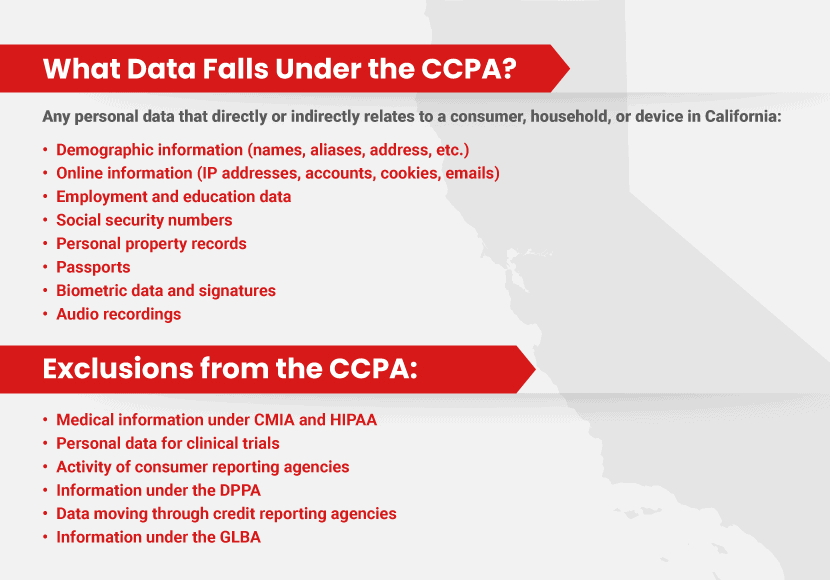
GDPR
Businesses must take the following actions to comply with the GDPR:
- Appoint a Data Protection Officer (DPO) if required. Designate a DPO to oversee compliance, communicate with regulators, and function as a contact for data subjects.
- Conduct Data Protection Impact Assessments (DPIAs). Perform DPIAs for high-risk processing activities to evaluate and mitigate data privacy risks.
- Implement “Privacy by Design” and “Privacy by Default”. Ensure data protection is integrated into systems and processes from the outset, processing only necessary data.
- Establish lawful bases for processing. Document legal grounds for all personal data processing, such as consent or legitimate interest.
- Obtain valid consent when necessary. Where consent is needed, ensure it is freely given, specific, informed, and easily withdrawn.
- Maintain records of processing activities. Keep detailed documentation of processing purposes, data categories, recipients, retention periods, and security measures.
- Develop processes for data subject rights. Create mechanisms to handle GDPR rights requests, such as data access, rectification, and erasure.
- Ensure compliance for data transfers outside the EEA. Implement safeguards like Standard Contractual Clauses for cross-border data transfers.
- Establish a data breach response plan. Prepare to detect, investigate, and report data breaches within 72 hours when required.
- Employee training on GDPR requirements. Conduct training to ensure staff understand GDPR obligations and their roles in maintaining compliance.
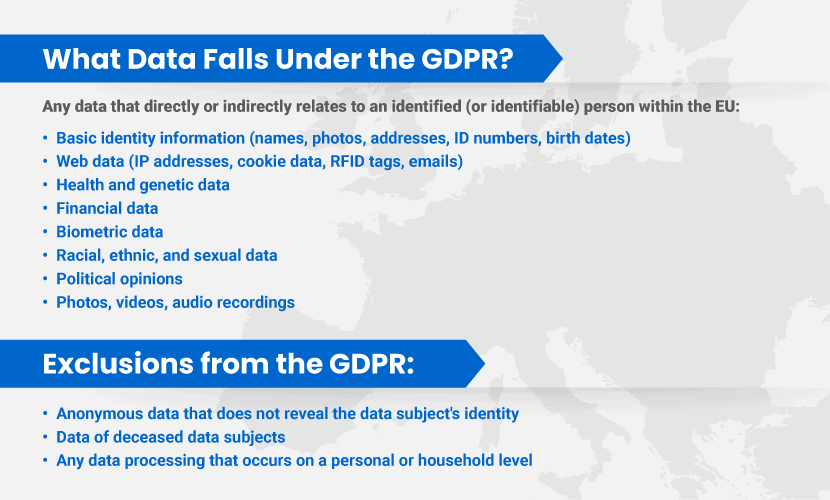
Did GDPR Inspire CCPA?
Though developed independently, the GDPR undeniably set the stage for modern data privacy, casting a wide influence that reached across borders, including California’s CCPA. GDPR’s rigorous focus on data rights, transparency, and user control over personal information raised the global bar for privacy laws, urging other regions to reconsider their own approaches.
While the CCPA borrows some of GDPR’s core principles, such as prioritizing transparency and empowering consumers with control over their data, it remains distinctly Californian, shaped to fit the U.S. legal landscape and California’s specific needs.
Navigating Global Data Privacy Standards
For businesses operating internationally, tackling GDPR and CCPA compliance is essential. These regulations share a common mission of protecting personal data and enhancing privacy rights, yet they approach it with different definitions, reach, and rules.
To keep up, companies must take a hard look at how they collect, process, and share data, tailoring compliance strategies that satisfy each law’s distinct requirements. By aligning with these regulations, businesses reduce legal exposure and earn the confidence of consumers increasingly mindful of data privacy and the security of their personal information.



